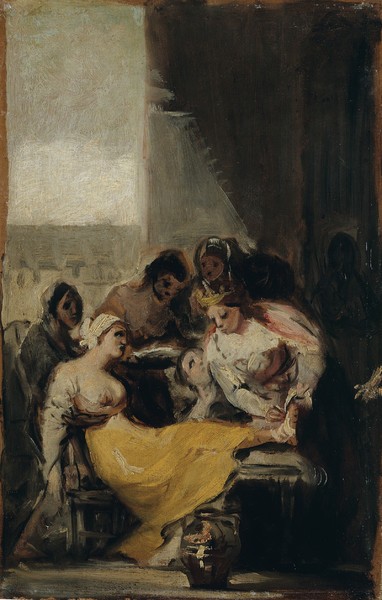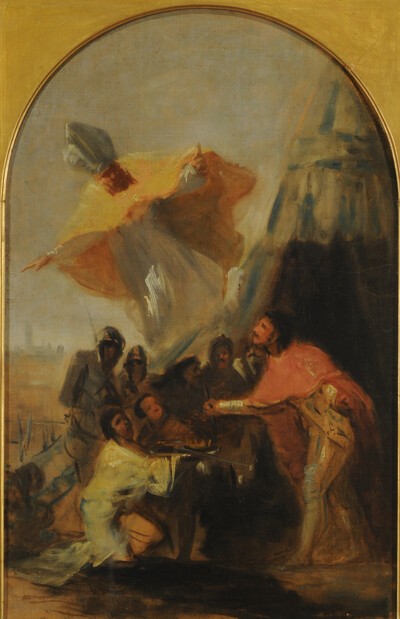- Cronología
- Ca. 1799
- Ubicación
- Lázaro Galdiano Museum, Madrid, Spain
- Dimensiones
- 32 x 22 cm
- Técnica y soporte
- Oil on canvas
- Reconocimiento de la autoría de Goya
- Undisputed work
- Titular
- Lázaro Galdiano Foundation
- Ficha: realización/revisión
- 27 Jan 2010 / 13 Jun 2023
- Inventario
- (2021)
- Otros títulos:
-
Saint Elizabeth Curing the Lepers (Santa Isabel curando a los leprosos)
See Apparition of Saint Isidore to Saint Ferdinand III. This sketch belonged to Martín Zapater, and was inherited by his grand-nephew Francisco Zapater y Gómez. In 1900 it entered the collection of Mr Clemente Velasco, who sold it to Mr José Lázaro some time between 1928 and 1936. The work was entrusted to the museum bearing his name in 1951.
The painting corresponding to this sketch was located on the Evangelical side of the church. The subject has often been confused with Saint Elizabeth curing the lepers, but here Goya is illustrating a different, albeit similar chapter in the saint's life, most probably inspired by the biography narrated by Father Juan Carrillo. The Aragonese saint, daughter of Peter the Great, cured a woman whose foot was full of wounds which doctors could not heal. When the queen attended her, the foot was miraculously healed, the sick woman finding comfort in God.
The sketch is not a polished work: the brushstrokes are energetic, the faces are hardly defined at all, and the colour palette is limited to ochres with a few touches of red and yellow. The scene is lit up by the window on the left-hand side, illuminating the most important figures. The saint and the sick woman are denoted by their respective crown and headscarf. Although the artist takes care to signal the fact that Saint Elizabeth is a queen, he places the emphasis on her charitable vocation. It seems that Goya gave more importance to the action than to the order of the figures.
The sick woman has a bare chest, as if she did not have the strength to dress herself. Doubtless Goya would have modified this detail in the definitive work, since it was destined for a holy temple. The artist had to retouch the painting in 1801 before the building was consecrated, as stipulated by the church authority and recorded in a document dated 24 November 1801 written by Larripa and addressed to the Secretary of State, Pedro Cevallos.
-
Goya 1900Ministerio de Instrucción Pública and Bellas ArtesMadrid1900consultant editors Aureliano de Beruete, Alejandro Ferrant, Marqués de Pidal and Ricardo Velázquez. May 1900cat. 70: Clemente Velasco
-
Pinturas de GoyaMuseo Nacional del PradoMadrid1928consultant editor Fernando Álvarez de Sotomayor. From Apri to -May 1928cat. 32/90: Clemente Velasco
-
GoyaLa Lonja, Torreón Fortea y Museo Pablo GargalloZaragoza1992consultant editor Julián Gállegocat. 34
-
Goya. El Capricho y la Invención. Cuadros de gabinete, bocetos y miniaturasMuseo Nacional del PradoMadrid1993from November 18th 1993 to February 15th 1994. Exhibited also at the Royal Academy of Arts, London, March 18th to June 12th 1994 and The Art Institute of Chicago, Chicago, July 16th to October 16th 1994, consultant editors Manuela B. Mena Marqués and Juliet Wilson-Bareaucat. 57
-
Realidad e imagen. Goya 1746 – 1828Museo de ZaragozaZaragoza1996consultant editor Federico Torralba Soriano. From October 3th to December 1st 1996cat. 39
-
L'œuvre peint de Goya. 4 volsParís1928-1950p. 143, cat. 100
-
Bosquejo histórico de don José DuasoAnales del Instituto de Estudios Madrileños1968pp. 358-365
-
Vie et ouvre de Francisco de GoyaParísOffice du livre1970pp. 165, 194, cat. 738
-
BarcelonaPolígrafa1970vol. I, p. 318, cat. 460
-
L’opera pittorica completa di GoyaMilanRizzoli1974p. 115, cat. 389
-
Francisco de Goya, 4 vols.ZaragozaCaja de Ahorros de Zaragoza, Aragón y Rioja1980-1982vol. III, p. 127
-
Goya. El capricho y la invención. Cuadros de gabinete, bocetos y miniaturasMadridMuseo del Prado1993pp. 241, 242, 367, cat. 57 y p. 244 (il.
-
Goya y Aragón. Familia, amistades y encargos artísticoscol. Col. Mariano de Pano y RuataZaragozaCaja de Ahorros de la Inmaculada de Aragón1995pp. 184-190 y p. 189 (il.)
-
Realidad e imagen. Goya 1746 – 1828MadridGobierno de Aragón y Electa España1996pp. 126-128, cat. 39 y pp. 127, 129 (ils


